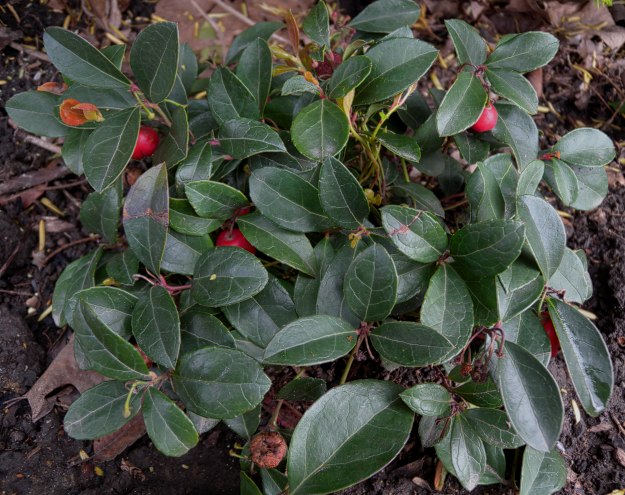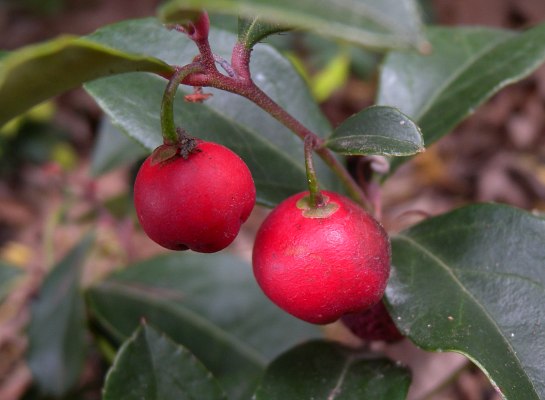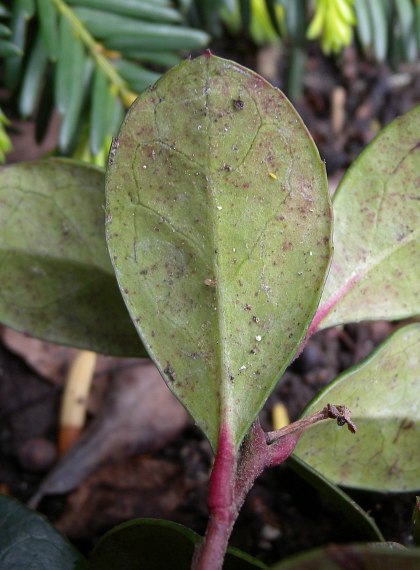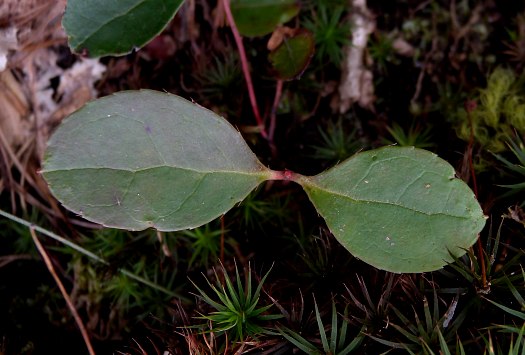
Each flower is about 1/3" (8 mm.) in length, consisting of a white bell-shaped corolla (sometimes tinted pink) with 5 short outwardly curled lobes, a white calyx with 5 ovate-oval lobes, 5 inserted stamens, and a pistil with a single stout style. The calyx is much shorter than the corolla. At the base of each flower, there is a pair of tiny ovate to heart-shaped bracts; these bracts can be light green, white, or red, and they have membranous margins. The pedicels of the flowers are up to 1/3" (8 mm.) in length, light green to red, and more or less terete; they are sparsely to moderately covered with appressed white hairs. The blooming period occurs from early to mid-summer, lasting about 3 weeks. The flowers are reported to be fragrant. Afterwards, fertile flowers are replaced by berry-like fruits that become mature during late summer or early autumn. Mature fruits are about 1/3" (8 mm.) or slightly more across, bright red, and globoid in shape; they have a fleshy interior that is slightly sweet and minty (wintergreen) in flavor. Each fruit contains many tiny seeds. The root system has shallow rhizomes, from which clonal subshrubs develop. The evergreen foliage becomes reddish or purplish during the autumn.

Cultivation: The preference is partial sun to light shade, moist to dry-mesic conditions, relatively cool temperatures, and somewhat acidic soil containing either sand or loam with decaying organic matter. Growth and development are relatively slow. Flowers and fruits are more likely to be produced in brighter locations. The seeds are difficult to germinate.
Range & Habitat: Wintergreen (Gaultheria procumbens) is native to northern Illinois, where it is rare and state-listed as 'endangered' (see Distribution Map). Elsewhere within the state, it is absent from natural areas. Wintergreen occurs primarily in the Great Lakes region, northeastern USA, and adjacent areas of Canada; it also occurs in the Appalachian mountains in high-altitude areas. In Illinois, the habitats of this sub-shrub are largely restricted to upland oak woodlands, wooded hillsides, forested bogs, and shrubby bogs. In more northern areas, it is often found in coniferous woodlands, mixed woodlands, and shrubby meadows. Wintergreen occurs in high quality natural areas in Illinois. It is easily topkilled by wildfires, although the thinning of the tree canopy and reduction of taller shrubs can cause populations of this sub-shrub to increase.

Faunal Associations: Bumblebees are the primary pollinators of the flowers. Other floral visitors include cuckoo bumblebees (Psithyrus spp.) and the honeybee. Nectar is the primary floral reward for these insect visitors (Mirick & Quin, 1981; Reader, 1977; Lovell, 1898). Other insects feed on the plant sap or foliage of Wintergreen (Gaultheria procumbens). These species include an aphid (Illinoia borealis) and larvae of two moths, Cameraria gaultheriella and Rhopobota naevana (Blackman & Eastop, 2013; Ferguson, 1975; Needham et al., 1928). Birds and mammals also use Wintergreen as a source of food. The Ruffed Grouse eats the buds, leaves, and fruits; the Bobwhite Quail, Ring-necked Pheasant, and the extinct Passenger Pigeon eat (or ate) the fruits (Bennetts, 1900; Martin et al., 1951/1961; Coladonato, 1994; Schorger, 1955). This sub-shrub provides protective cover for the nests of the rare Kirtland's Warbler in Jack Pine barrens in the state of Michigan (Buech, 1980). Mammals feeding on this sub-shrub include the American Black Bear (leaves & fruits), Red Fox (fruits), Eastern Chipmunk (leaves & fruits), Elk (leaves & twigs), White-tailed Deer (leaves & twigs), Deer Mouse (fruits), and White-footed Mouse (fruits); see Coladonato (1994), Martin et al. (1951/1961), Schneider et al. (2006), Hamilton (1941), and Schloyer (1976) for more information. Fruit-eating birds and mammals spread the seeds to new locations.

Photographic Location: A flower garden at the Urbana Free Library in Urbana, Illinois, and a wooded hillside at the Pine Hills Nature Preserve in west-central Indiana.
Comments: The most striking characteristic of this plant is the mint (or wintergreen) fragrance of its crushed leaves, from which oil of wintergreen is made. Even without flowers or fruits, Wintergreen (Gaultheria procumbens) can be identified by the size, shape, and fragrance of its leathery evergreen leaves. Another species in this genus, Creeping Snowberry (Gaultheria hispidula), is found north of Illinois in more boreal areas. Its crushed leaves have the same wintergreen fragrance, but Creeping Snowberry differs from Wintergreen by its prostrate habit of growth, white berry-like fruits, and smaller leaves. Other similar species in the Heath family (Ericaceae) are either larger shrubs or their leaves lack the wintergreen fragrance. Other common names of Gaultheria procumbens are Teaberry and Checkerberry.